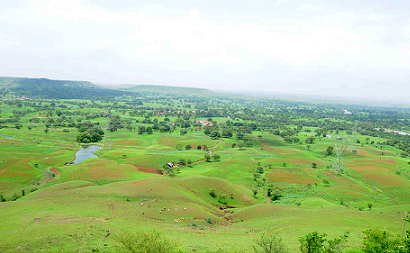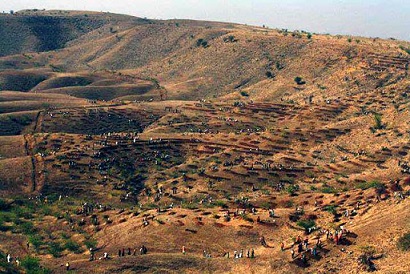Rainwater seeps, greenery abound; Jhabua tribal tradition starts paying

Manish Vaidya
Jhabua: Though it’s early monsoon yet and southwestern district of Jhabua hasn’t received too much of rainfall – a look at the lush green Hathipawa hillock on outskirts of the district headquarters really heartens one.
This is particularly so, because for last several years, the hillock lay bare and barren and even as people in adjoining settlements struggled for water, whatever rain fell on this hillock ran off and got wasted.
But things changed in March this year when a congregation of 6000 odd tribal people from the district decided to implement an interesting tradition to ensure that rainwater harvesting was possible on this vast stretch of barrenness.
On March 15, these tribal people – including numerous women – marched from Jhabua town to Hathipawa – shovels and spades in hand and within five hours dug 15,000 contour trenches all around the hillock. Not only this, they also cleaned up 25,000 more contour trenches that had been dug some years ago but had got silted since then.
Thus, 40,000 contour trenches are ready to lap up the rainwater during the current rainy season.

This community work was performed under the tradition of ‘Halma’ and not a single rupee was sought against the work by anyone. The cost of the work at government rate is estimated at Rs 10 lakh.
Halma is a tribal tradition of the region, where community members complete a community work by pooling voluntary labour. No remunerations are taken but there is unwritten assurance that the gesture would be reciprocated whenever any such effort is needed.
Many such smaller water conservation structures have been prepared through Halma across the districts, but the magnitude of the work at Hathipawa is appreciable.
And while the tribals at Hathipawa undertook the work as part of a tradition and with an aim to conserve rainwater and stop soil erosion, they probably did not realize the enormity of the good work done by them.
Let’s consider this interesting calculation:
Geologist Sunil Chaturvedi explains that contour trenches are series of pits/ditches of square or rectangular dimensions dug along the contour of a sloping land. They are fortified on the downhill side with a narrow shelf using the soil dug from the trenches. These shelves can be used to plant foliage.
One contour trench, by rough estimate can retain and recharge 10,000 litres of rainwater during a monsoon season. This means that the 40,000 trenches would lead of recharging of about 40 crore litres of water during rainy season.
Since one person required average 70 litres of water per day, the water would be sufficient for 57, 14,285 people for a day. As the population of the nearby Jhabua town is about 40,000, the water would be sufficient for 143 days or about 5 months.
Imagine that.
But the tribal people are only interested in more basic things. Bhuribai, one of the volunteers at Halma said that they do manual labour throughout year to eke livelihood, but such community work of a day gives them immense pleasure and also helps in the major task of water conservation.
Chayn Singh says that rainwater has started to collect and seep at the structures prepared by them and the hillock has turned unbelievably green. Kalu Singh mentions that people only keep exploiting groundwater but fail to give it back to land. “We have done this so that we have water. We can survive only if earth and water survive. We have to take initiative for that.”
(Manish Vaidya is an independent journalist, contributing to NewsBits.in)










